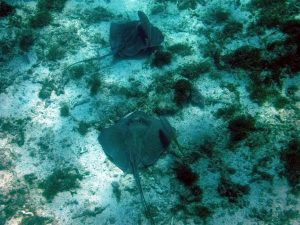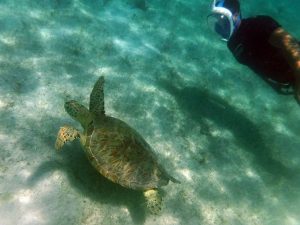Composed of two small islands, the archipelago of Petite terre is a nature reserve characterized by its large population of iguanas and hermit crabs. On these islands stands also the oldest lighthouse in Guadeloupe.







Snorkelling sessions, barbecues on the beach underneath the palm trees, sightseeing, visit of the notorious lighthouse as well as a trip on a catamaran under the close surveillance of dolphins… Tarzan takes you on a journey to Petite terre, a nature reserve mostly preserved from human activity.
Discovered by Christopher Columbus in 1493, the archipelago was originally inhabited by fishermen and hunters from the Indian tribes Arawaks and Caraïbes, as shown by potteries and carved stones found on the islands. The Europeans then colonized Petite terre in the 18th century. With them, they brought a new way of life and introduced agriculture on the islands.
While wandering on the archipelago you may indeed catch sight of stonewalls used at the time to divide cultivated land, thus demonstrating how well agriculture was organized.
In 1840, due to the development of maritime trade and fishing, the first Guadeloupian lighthouse was built on Terre de Bas, the largest of the two islands. Named “the lighthouse on the edge of the world” by locals, it is 23 meters tall and stands 35 meters above sea level. The building is today no longer used to ensure the safe passage of boats and ships but as a wildlife museum. When visiting the lighthouse, you can admire the archipelago’s marvellous fauna and flora.
The isles of iguanas, truly a nature reserve
Petite terre hosts approximately 10 000 Lesser Antillean iguanas, one third of the species world’s population. It’s thus very likely that you may catch a glimpse of these wild animals. These iguanas are entirely vegetarian, perfectly harmless and can reach a length of 1m60.
Genuine emblem of the islands, the Hermit crab is also widely present on the archipelago. This thief shellfish, called « souda » in creole, usually hides inside the shell of other animals and it is not rare to see them wandering by dozens on the humid parts of the islands.
While hiking, you may also admire other wild animals such as lizards, fishes, turtles, rays, dolphins, sea urchins, shellfishes, crawfishes, migratory birds, etc. At the same time, flora is very abundant with Gaïac wood, which was once used to make billiard balls, and the agave plant, which only flourishes once in its lifetime, being two protected species. Therefore, in 1998, Petite terre gained the status of marine and nature reserve.
Terre de Haut, the smaller island of the archipelago, is in fact strictly forbidden to tourists. Only scientists and nature reserve wardens have access to the island. Due to its status, the number of visitors on the archipelago of the archipelago is limited. Nonetheless, Tarzan holds the accreditations and welcomes you to join the isles of Petite terre aboard a beautiful catamaran. The duration of the trip is about 1h30 and Tarzan will provide you masks and snorkels for the snorkelling session…



Articles récents
This post is also available in: Français








